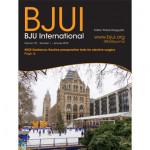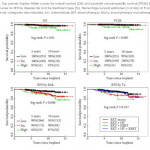Editorial: LDR prostate brachytherapy in younger men
Langley et al.1 report on the oncological and functional outcomes of men treated with low dose rate (LDR) prostate brachytherapy in men 60 years old or younger. 597 patients with a median (range) age of 57 (44-60) years had a median follow-up of 8.9 (1.5-17.2) years. The 10- year post-implant relapse free survival using the Phoenix definition for biochemical failure (nadir plus 2 ng/ml) was 95%, 90% and 87% for low, intermediate and high-risk disease, respectively. Potency was preserved in 75% of men potent before treatment. The authors concluded that LDR brachytherapy is an efficacious treatment with excellent long-term control of prostate cancer in men ≤60 years at time of treatment. While the results from this investigation are encouraging, enthusiasm should be tempered given the short follow up, long natural history of prostate cancer and the long-life expectancy for these younger patients.
Although the overall median follow-up was 8.9 years, the calculation of PSA-free failure was derived from a median follow-up of 5.9 years. As this investigation did not identify men who may also be at risk of failure because of a rising PSA and who have not yet reached the Phoenix threshold, I anticipate longer-follow up will further reduce their favorable results. Of the 597 men, 6 (1%) died from prostate cancer. The low incidence of prostate cancer mortality, while impressive, also reflects the short follow-up. Our group has previously reported that PCSM substantially increases between the 10th and 15th year post treatment. The experience of these physicians in prostate brachytherapy is demonstrated in their favorable dosimetry outcomes-the median D90 was 106.4% of the prescription (145 Gy). These results (median D90 154.3 Gy), which were determined and computed on the day of the implant would be 10-15% higher had the CT scans been done on day 30 as most centers do. We and others have reported that patients receiving higher dose implants have improved biochemical and cancer-specific outcomes. While these data help explain their favorable oncological outcomes, they should also serve as a guide to other brachytherapy programs where implant quality should be a primary objective. Erectile function was preserved in 75% of men. These data are consistent with other reports of younger men who were treated for prostate cancer with surgery or radiation. Because this was not a randomized study, it is not possible to make direct comparisons between surgery and brachytherapy. The selection of an IIEF score of > 11 as potent might be challenged as the 12-16 group is considered to have mild to moderate ED. Nonetheless, these data are still encouraging for younger men who are considering treatment for localized prostate cancer where sexual function preservation is important.
Nelson Stone
Mount Sinai Medical Center – Urology 350 E 72nd Street, New York, New York 10021 United States
Reference
- Langley SM, Soares R, Uribe J, et al. Long-term oncological outcomes and toxicity in 597 men ≤60 years of age at time of low dose rate brachytherapy for localised prostate cancer. BJU Int 2017



